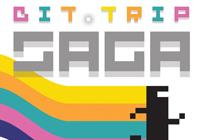Bit.Trip Saga (Nintendo 3DS) Review
By Adam Riley  13.07.2012
13.07.2012

Gaijin Games has been hailed by media the world over for its intriguing take on the rhythm genre, mixing retro-styled visuals with funky beats into varying forms of traditional gameplay. After having great success in their individual formats on the WiiWare download service, and being compiled for a Wii disc release at retail -- complete with extras -- what of the assemblage on Nintendo 3DS? Should it warrant equal amounts of attention?
The game that started it all off is none other than Bit.Trip Beat, which is basically a rhythm-based version of the classic Pong, with players controlling a paddle on the left-hand side of the screen and just simply moving it up and down to repel incoming pixels of varying sizes that move in numerous diverse ways and at different speeds to try and catch the player out. There is very good reason for this being the highlight of the bunch since it was the first released on WiiWare and quickly garnered a faithful following thanks to its addictive qualities and excellent chip-tune soundtrack.
Next on the list is Bit.Trip Core, a game that worked extremely well on WiiWare, but sadly seems to have lost a slight bit of its ‘fizz’ in the transition to 3DS, perhaps due to the poor directional pad of the portable system compared to the Wii Remote. However, it still proves to be one of those highly frustrating games that can somehow manage to entice the player back for yet another try. As before, it is a simple affair, and yet so dastardly difficult, with a small cross in the middle of the screen and the ability to shoot a light beam in one of four directions before tapping the fire button to blast the dots that move past. Whereas many titles are praised for keeping the background imagery down to the bare necessities for the sake of retaining sanity and proper eye function, Bit.Trip Core takes the opposite stance on purpose to try and distract as much as possible. If the D-pad was not so weak on the 3DS, this would have been wonderful, but trying to quickly follow the changing patterns of pixel squares dancing onto the screen by pressing up, down, left or right at the appropriate time in quick succession before hitting the fire button proves cumbersome at times.

Bit.Trip Void is another fantastic addition to the bulging roster of six, and takes a distinctive approach with a small black ball being moved around the screen, gradually growing in scale as more black dots are absorbed into the ‘void’ and everything being lost upon contact with a white block. The larger the void becomes, the higher the score amassed when its contents are manually released. However, movement becomes increasingly slower, and the boost in size obviously makes dodging whites progressively harder. Therefore, it becomes a fine balance between claiming as many blacks as possible before having to release them for a score bonus, all the while avoiding unwanted contact. Bit.Trip Runner is by far the highlight of the bunch, with its wealth of moves, wicked beats, and crazy platform stages to dash through. There are no lives to lose, just simple restarts, with the player having to go all the way back to the beginning of a specific level if any obstacle is hit along the way. Press down to slide under objects, up to launch from springboards, ‘Y’ to kick through blockades, ‘B’ to jump in the right places, and so on. The combination of moves required to reach the end goal may seem daunting at first, but Bit.Trip Runner eases each move into the repertoire expertly. It is no wonder a sequel is being made based around this idea alone; true magnificence.
Moving onto Bit.Trip Fate then, sadly, is comparatively a backwards step. The lead character, CommanderVideo, is stuck to an oscillating pathway, running from left-to-right, with the player able to manually move him from side-to-side (and, thus, up and down the wave) in order to successfully elude contact with damaging shots. The way that the movement using the Circle Pad is carried out, though, makes for positioning CommanderVideo in the right place horribly awkward, especially when faced by an onslaught of fire. The stylus is used here for shooting, with several upgrades available as play goes on, but constantly shooting purposefully slows character movement in order to deter non-stop shooting that might make proceedings a little easier. The concept is clearly meant to challenge traditional ‘shmups’ but unfortunately becomes too frustrating. Last, but not least, is Bit.Trip Flux, which is basically Bit.Trip Beat, except with the paddle on the right-hand side of the screen now, and the difficult level upped ridiculously high to include all sorts of objects to avoid, an Arkanoid-meets-Pong section, and much more to make your brain and eyes hurt!

Cubed3 Rating
Very Good - Bronze Award

The mixture of varying styles throughout the entire Bit.Trip Saga package is enough to keep fans of rhythm games content thanks to it proving to be far more than a run-of-the-mill music-based product, instead being a wonderful combination of great tunes and intriguing genre-splicing. Although there are elements that should have been included, as with the Wii version, Bit.Trip Complete, those wanting a portable taste of Gaijin Games’ cult hits should look no further than this 3DS release.

![]() 7/10
7/10
![]() 0
(0 Votes)
0
(0 Votes)
 Out now
Out now  Out now
Out now  Out now
Out now  Out now Also on
Out now Also on 
Comments
Comments are currently disabled

 Sign In
Sign In Game Details
Game Details Subscribe to this topic
Subscribe to this topic Features
Features





 Top
Top

